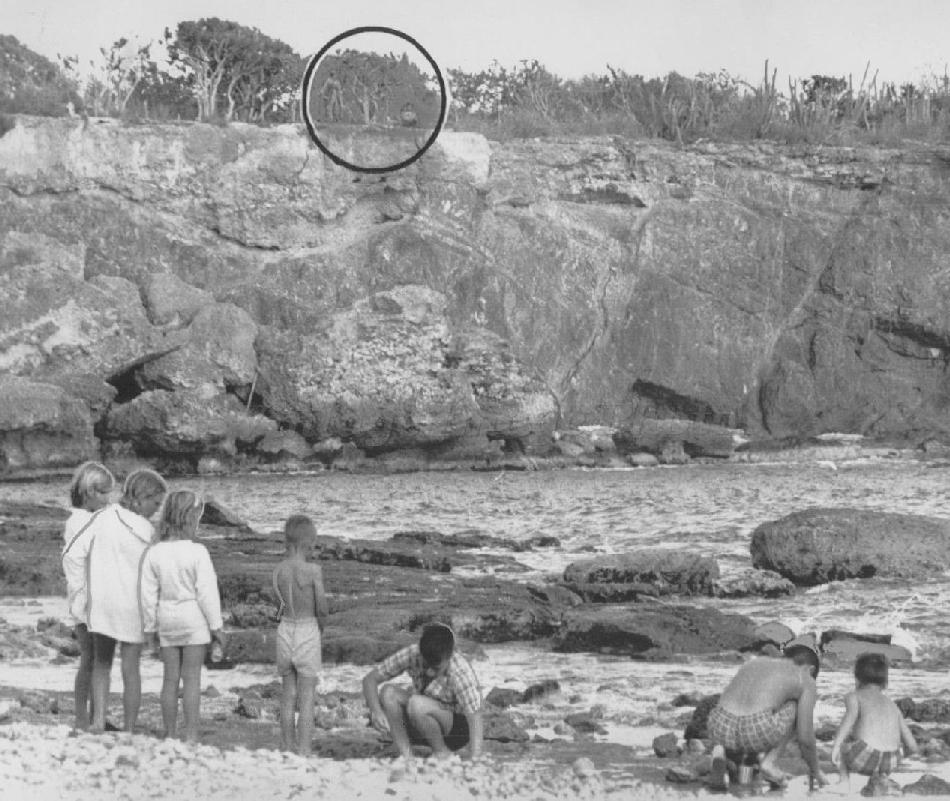
Guantanamo: American Naval Base

Figure 1.--This 1964 press photo shows the children of U.S. servicemen playing along Kittery Beach with Cuban gun emplacements on the cliff beyond. The press photo read, "Guantanamo Naval Base: Children of U.S. servicemen play unconcerned on Kittery Beach while Cuban sentroes warchFebruary 16. The american parents are not worried by the Cuban guns. So far, the weapons never have been fired. The U.S., in drastic snswer to Cuban Premier Fidel Castro, has cut the now unused water pipes from Communist Cuba to this huge base."
|
|
One website we found which pretends to be a serious site, begins a dscussion of Guantanao by stating that "Guantanamo Bay has become one the most infamous places on earth." Now there are places where millions of people have been kiled, such as the NAZI death camps or the Cambodian killing Felds. And countless places where thousands of people have been killed, even tens of thousands such as the Katyn Forrest, Babi Yar, the Warsaw Ghetto, the Japanese Rape of Nanking, Vietmanese 'reeducaion camps,' Soviet Gulag camps, the Twin Towers, and many more such places. The author who calls Guantamao 'one the most infamous places on earth' does not even mention how many people died at Guantanamo. There is of course a reason. The United States detained some 780 individuals at Guantanamo. Since the U.S. began holding terror suspects at Guantanamo, there have been a mere six deaths, all reportedly suisides. Now no matter what one thinks of the use of Guantanamo, calling it one of the most 'infamous places on earth' is obviously absurd. ne should look at the starving people killed by totalitarians and compare them with the Guantamo detainees ho actually gained weight. Statements like this simply reveal the author's hidden agenda to darken the image of the United States and President Bush. I do not mean to say that criticism is inappropriate, but only the statements made are absurd made by people who are determinted to prove that America is not a nobel nation and not ouy of any desire to rationally discuss the isues. The history of Guantanamo dates back to Spanish American War (1898-99). French efforts to build a canal across the Istmus of Panana began to make it a real prossibility (1876). And as the United States began building a modern navy (1890s), the United states became intereted in such a canal and Caribbean bases to protect it. Vice President Theodore Roosevelt was a Navy entusiast, seving as Under-Secretary of the Navy during the McKinnley administration. The opportunity to obtain a naval base in the Caribbean came when the United States declared war on Spain and intervened in Cuba, at the time a Spanish colony embroiled in a four decade revolution (1898). The result was Cuba's liberation from Spain and an American naval base at Guantanamo Bay, a magnificent natural harbor. The base was used by the Navy for a variety of pourposes, at first as a coaling station. Before the conversion to oil, a navy needed coaling stations in areas in which it operated. A ship could not carry enough coal to go a long distance without needing more coal and at sea refuelng was not possible with coal. It was also used as a ship repair facility, and a naval suppport point for ships headed to Europe during World War I and II. Guantanamo has also served to support Caribbean hurricane relief operations. And finally it us been used as a secure incarceration facility for suspected terrorists. Until the Cuban Revolution, Guantanamo was virtually unknown to Americans outside the Navy. Castro made a major issue of the Cuban base long before the terrorist detention camp became an issue.
CIH

Navigate the Children in History Coldar Boys' Historical Clothing Web Site:
[Return to the Main Totalitarian Communist Cuba page]
[Return to the Main Cuban history page]
[Return to the Main Caribbean history page]
[Return to the Main Latin American history page]
[Return to the Main Latin American page]
[Return to the Main countries page]
[About Us]
[Introduction]
[Biographies]
[Chronology]
[Climatology]
[Clothing]
[Disease and Health]
[Economics]
[Freedom]
[Geography]
[History]
[Human Nature]
[Law]
[Nationalism]
[Presidents]
[Religion]
[Royalty]
[Science]
[Social Class]
[Bibliographies]
[Contributions]
[FAQs]
[Glossaries]
[Images]
[Links]
[Registration]
[Tools]
[Children in History Home]
Created: 10:49 PM 5/31/2016
Last updated: 10:50 PM 5/31/2016



